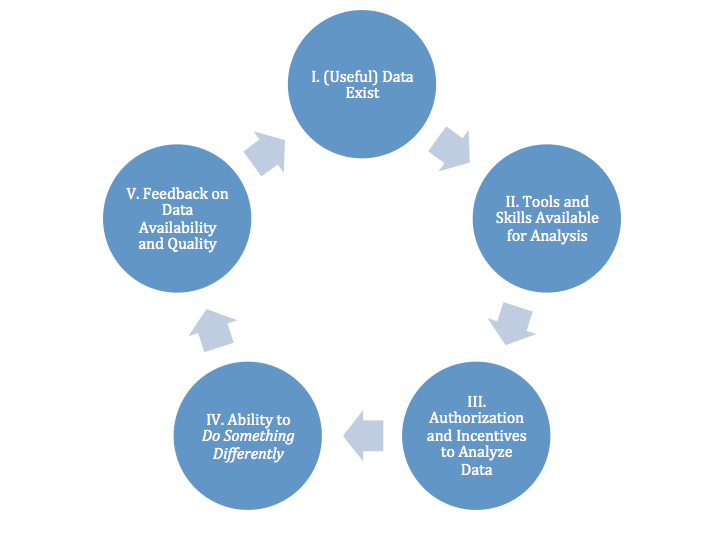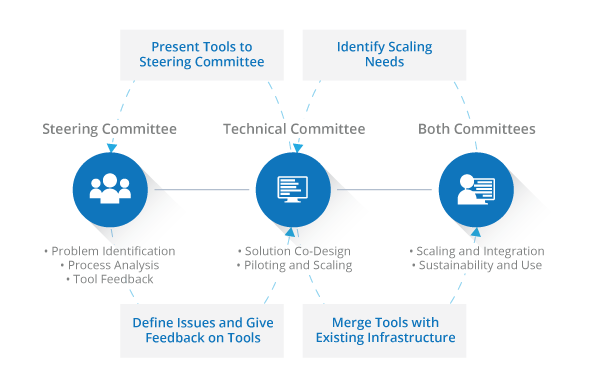Using PDIA to Put Data Into Action
We recently wrote about how the data for development community needs to take a more context aware, demand-driven approach to data. Applying theories of change – models of how strategies and inputs result in expected impact – to match political economy, institutional structures, human resources, and data sources can help us find ways to merge data into policy and decision-making processes. For example, using naming and shaming may work well in one context, but backfire significantly in others.
In our Results Data Initiative, we are putting this approach to the test.
Start by Learning the Context
We started by talking to nearly 500 data collectors, managers, and user to learn about their results data ecosystems. We found that, across contexts, the perceived value of data hinged on the ability to do something differently. So how can we know when actors can do something differently? It’s a magical combination of (i) fit-for-purpose data, (ii) tools and skills, (iii) individual authorization, and (iv) policy and/or budget flexibility – all of which ideally results (v) in feedback on data to improve the cycle.

Changing our Approach
We all know by now that policy processes, governments, and development problems are complex. In Tanzania, policy and program decisions in health involve multiple government ministries, district governments, development agencies, and so forth – so we can’t rely on the same old “project model.”
We are taking a problem-driven, iterative, adaptive approach (PDIA) – meeting policymakers where they are and addressing the problems they prioritize.

Our approach is grounded in the following principles:
Begin with the end: bringing “problem holders/authorizers” together to define priorities
Through RDI, we are bringing together senior officials from across government to identify existing policy or operational challenges where officials want to use data. In particular, we are looking for problems where (i) inflection points for influence exist (e.g., budget cycles, new policies, evaluations), and (ii) policymakers agree that data/evidence are needed to inform these decisions.
This authorizer-driven activity aims to identify the right questions for the fourth step in our data cycle: identify where our can partners do something differently with the right evidence. It also creates the authorizing environment identified in the third constraint.
Co-creating with government “problem solvers/testers”
We will also use these quarterly meetings to initiate the co-creation process with senior officials through a joint learning approach. Based on their guidance, we’ll work closely with their technical staff (e.g., statisticians, ICT) to identify existing data sources, tools, and visualization/analysis methods to tackle priority challenges identified by management.
This activity aims to tackle the first three constraints in our data cycle: data, tools, and authorization for analysis.
Iterate and Adapt
In addition to close collaboration with technical staff, we will demonstrate these outputs to senior officials as these tools evolve. Gathering feedback on how effective, understandable, and useful these tools are will allow us to rapidly iterate and adapt to ultimately deliver tools and methods that get used.
This activity closes the feedback loop (constraint five) and carries us back through the data use cycle.
Sustain
From the start, we’ll focus on working with government technical staff to identify what existing systems and processes could serve as the foundation for these tools. By building into what already works, we can increase the odds of sustainability beyond our program.
Scale
As we gain traction on the initial set of priority problems, we will continue to engage our “problem holders” in identifying new challenges to tackle through this same approach in Tanzania. We’re also scoping out a second country for RDI (more on this soon!). We’d love to hear from others on how they’re tackling similar challenges, and will continue to share stories as we use PDIA to put data into action.
Share This Post
Related from our library

Harnessing the Power of Data: Tackling Tobacco Industry Influence in Africa
Reliable, accessible data is essential for effective tobacco control, enabling policymakers to implement stronger, evidence-based responses to evolving industry tactics and public health challenges. This blog explores how Tobacco Industry strategies hinder effective Tobacco control in Africa, and highlights how stakeholders are harnessing TCDI Data to counter industry interference.

Building a Sustainable Cashew Sector in West Africa Through Data and Collaboration
Cashew-IN project came to an end in August 2024 after four years of working with government agencies, producers, traders, processors, and development partners in the five implementing countries to co-create an online tool aimed to inform, support, promote, and strengthen Africa’s cashew industry. This blog outlines some of the key project highlights, including some of the challenges we faced, lessons learned, success stories, and identified opportunities for a more competitive cashew sector in West Africa.

Digital Transformation for Public Value: Development Gateway’s Insights from Agriculture & Open Contracting
In today’s fast-evolving world, governments and public organizations are under more pressure than ever before to deliver efficient, transparent services that align with public expectations. In this blog, we delve into the key concepts behind digital transformation and how it can enhance public value by promoting transparency, informing policy, and supporting evidence-based decision-making.